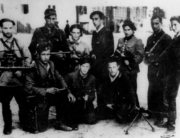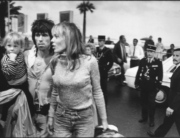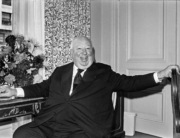The Rossellini family is a gift to filmmakers. Nearly a decade ago, auteur Roberto Rossellini’s relationship with Hollywood movie star Ingrid Bergman was the subject of Francesco Patierno’s The War of the Volcanoes. Now in The Rossellinis, the emphasis is not so much about a piece of film history, although that always hovers in the background, but on family conflict and the Italian director’s complicated—that’s putting it lightly—personal life. The film had its U.S. premiere at this year’s DOC NYC festival, and was among many, including another on a trailblazing photographer, that were apart of the “Photography & film” sidebar (besides Film, the Living Record of Our Memory and The Real Charlie Chaplin).
After making a short film about his grandmother Ingrid Bergman, Viva Ingrid!, Alessandro Rossellini has made his first feature-length film at 55, proof that it’s never too late. One might assume it would center mainly in Italy, but far from it. Roberto’s grandson travels the globe to reconnect with his aunts and a formerly playboy uncle. You’ll have a hard time guessing where his film ends up—in a Central Park dance party.
Intimate and upfront, the almost tell-all begins in 1977 with news footage of the funeral procession for Roberto, whose Open City brought acclaim to him and the postwar Italian film industry. In Alessandro’s words, the 1946 film became “a source of pride and obsession” for the family.
He delves into his famous family’s proclivities, what he calls Rossellinitis. He defines this syndrome as having a broken moral compass, “polygamy” (multiple marriages), and the predisposition for speaking your mind. In doing so, he deals with familial matters that most likely will not be well known. Here’s the family tree: Roberto’s first wife was Marcella, and they had a son, Renzo, the father of Alessandro. Roberto left Marcella in the late 1940s for his artistic collaborator Ingrid Bergman, and he divorced Marcella and married the Swedish-born movie star in 1950. They had three children, Robertino, also known as Robin (reputed to be “a modern-day Adonis,” per Alessandro), and twins Isabella and Ingrid.
While still married to Bergman, Roberto took off for India for work and returned to Italy a year later with the wife of a friend/collaborator, Sonali Das Gupta, along with her newborn son, Gil. They later had a daughter, Raffaella. Meanwhile, Renzo had a relationship with an African American dancer, Katherine Cohen, Alessandro’s mother. After his parents separated (Renzo’s parents disapproved of the relationship), Alessandro was raised by Nonna Raffaella.
In the eyes of his grandson, Roberto was governed by old-fashioned ethics (though apparently not marital laws) and machismo. Alessandro points to 1966’s The Taking of Power of Louis XIV as Roberto’s most autobiographical work, with his grandfather as the sovereign and the family serving as his court. In comparison to this Sun King of celluloid, his children were “losers from birth, hopeless” according to daughter Ingrid, who, as an Italian literature professor at Columbia University and Princeton, is no slouch.
Though some of the intergenerational reverberations are not deeply discussed, such as Alessandro’s drug addiction and the time when Roberto took the three children he had with Bergman away from her, Alessandro seeks out some form of reconciliation, including with Aunt Isabella, in the film’s most moving and open-hearted one-on-one. He also helps to deflate the alleged feud between the twin sisters regarding Ingrid’s reaction to Isabella’s cheeky tribute to her father in Guy Madden’s 2005 short, “My Dad is 100 Years Old.“
Exposing Muybridge
Stories and sex. Those are the contributions that pioneering photographer Eadweard Muybridge brought to the movies, according to writer and historian Marta Braun. She’s referring to the photographic series he made under the auspices of the University of Pennsylvania in the 1880s, whose purpose was to study movement of the human body. The scientific commission was also examining physical differences to promote a racial hierarchy.
Braun’s summation refers to Muybridge’s gratuitous attention to nude women, whether they were having tea or bathing. His photos aren’t formally stories but more suggestions of narratives, similar to the filmed slices of life that would gain other innovators, such as the Lumière brothers, acclaim and attention in the decades to come. As one of the early inventors of what would become motion pictures, Muybridge created a circular disc imprinted with a series of photographs. As the disc moved, the images were projected as though in motion.
Daring, duplicitous, mischievous: these are among the attributes describing the photographer within the documentary’s opening minutes, and director Marc Shaffer keeps the conversation chatty throughout, with roughly nine experts offering up a gossipy and thoughtful rendering of the man born Edward James Muggeridge into a working-class family in 1830 near London—he reinvented his career and his name more than once and then some. If you are unfamiliar with the biography of the British-born artist, Shaffer’s film will indeed serve its purpose as an exposé. Scandal and betrayal will follow.
Perhaps what Muybridge is more famous for are his photos of Yosemite and other areas of the West after the Civil War. He was also a daredevil: he sat for an image of Yosemite Valley’s Contemplation Rock, sitting on its edge overlooking a 3,000-foot drop. Historian Richard White frames the photographer’s output as part of the “selling of the West,” when the borders of the United States expanded; Muybridge worked for corporations and government interests while making photos for himself.
In many cases, he provided the only photographic documentation of native tribes. At Alaska’s Fort Tongass, he was the first to record an Indigenous culture that would vanish or irreparably change. However, as noted by photographer Mark Klett, “there is no such things as a neutral photograph.” In fact, Muybridge staged a battle between Whites and Modoc Indians, images of which were used for illustrations in Harper’s Weekly.
One on-screen expert is Oscar-winning actor Gary Oldman, a Muybridge collector, and it is no surprise that he holds the audience’s attention while pointing to important details of the photographer’s work and persnickety personality. The result makes a strong case for talking-head interviews. Here, they are nothing less than engaging and filled with personality.








[…] Exposing Muybrige by Marc Shaffer stars Oscar-winning actor Gary Oldman, a Muybridge collector, whose enthusiasm holds the audience’s attention, according to Film-Forward. […]
[…] Exposing Muybrige by Marc Shaffer stars Oscar-winning actor Gary Oldman, a Muybridge collector, whose enthusiasm holds the audience’s attention, according to Film-Forward. […]
[…] Exposing Muybrige by Marc Shaffer stars Oscar-winning actor Gary Oldman, a Muybridge collector, whose enthusiasm holds the audience’s attention, according to Film-Forward. […]
[…] Exposing Muybrige by Marc Shaffer stars Oscar-winning actor Gary Oldman, a Muybridge collector, whose enthusiasm holds the viewers’s consideration, in keeping with Movie-Ahead. […]
[…] Exposing Muybrige by Marc Shaffer stars Oscar-winning actor Gary Oldman, a Muybridge collector, whose enthusiasm holds the audience’s attention, according to Film-Forward. […]
[…] Exposing Muybrige by Marc Shaffer stars Oscar-winning actor Gary Oldman, a Muybridge collector, whose enthusiasm holds the audience’s attention, according to Film-Forward. […]
[…] Exposing Muybrige by Marc Shaffer stars Oscar-winning actor Gary Oldman, a Muybridge collector, whose enthusiasm holds the audience’s attention, according to Film-Forward. […]
[…] Exposing Muybrige by Marc Shaffer stars Oscar-winning actor Gary Oldman, a Muybridge collector, whose enthusiasm holds the audience’s attention, according to Film-Forward. […]
[…] Muybrige aussetzen von Marc Shaffer mit dem Oscar-Preisträger Gary Oldman, einem Muybridge-Sammler, dessen Enthusiasmus die Aufmerksamkeit des Publikums auf sich zieht, entsprechend Film-Forward. […]
[…] Exposing Muybrige by Marc Shaffer stars Oscar-winning actor Gary Oldman, a Muybridge collector, whose enthusiasm holds the audience’s attention, according to Film-Forward. […]
[…] Exposing Muybrige by Marc Shaffer stars Oscar-winning actor Gary Oldman, a Muybridge collector, whose enthusiasm holds the viewers’s consideration, in keeping with Movie-Ahead. […]